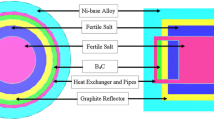Abstract
Tritium breeding ratio (TBR) is one of the important parameters in design of a Deuterium–Tritium (DT) driven hybrid reactor. Therefore, selection of tritium breeder materials to be used in the blanket is very crucial. In this study, tritium breeding potential of the solid breeders, namely, \({\hbox{Li}}_{2}{\hbox{O}}, {\hbox{LiAlO}}_{2}, {\hbox{Li}}_{4}{\hbox{SiO}}_{4}, {\hbox{Li}}_{2}{\hbox{ZrO}}_{3}, {\hbox{Li}}_{8}{\hbox{ZrO}}_{6}\) or \({\hbox{Li}}_{2}{\hbox{TiO}}_{3}\) in a (DT) fusion driven hybrid reactor fuelled with \({\hbox{ThO}}_{2}\) or \({\hbox{UO}}_{2}\) was investigated. For this purpose in addition to these solid breeders, different types of liquid breeders, namely natural lithium, Flibe, Flinabe and \({\hbox{Li}}_{20}{\hbox{Sn}}_{80}\) were used to examine the tritium breeding behavior of liquid–solid breeder couple combinations. Numerical calculations were carried out by using Scale 4.3. According to numerical results, the blanket with \({\hbox{UO}}_{2}\) fuel using natural lithium as coolant and \({\hbox{Li}}_{2}{\hbox{O}}\) as solid breeder had the highest TBR value.









Similar content being viewed by others
REFERENCES
W. J. Hogan and E. Bertel, Introduction: Inertial Fusion Energy Fundamentals, Energy from Inertial Fusion, (Eds) W. J. Hogan, J. Coutant, S. Nakai, V. B. Rozanov, G. Velarde, (IAEA, Vienna 1995)
Şahin S., Al-Kusayer T. A., Abdul Raoof M. (1986) Preliminary design studies of a cylindrical experimental hybrid blanket with (deuterium-tritium) driver. Fusion Technol. 10:84
Şahin S., Yapıcı H. (1989) Investigation of the neutronic potential of moderated and fast (D,T) hybrid blankets for rejuvenation of CANDU spent fuel. Fusion Technol. 16:331
Şahin S., Yapıcı H. (1998) Rejuvenation of light water reactor spent fuel in fusion blankets. Ann. Nuclear Energy 25:1317
Übeyli M. (2004) Utilization of ceramic uranium fuels in ARIES-RS fusion reactor. J. Fusion Energy 23(1):41
Yapıcı H., Übeyli M., Yalçın Ş. (2002) Neutronic analysis of Prometheus reactor fueled with various compounds of thorium and uranium. Ann. Nuclear Energy 29:1871
Abdou, M., et al., Blanket comparison and selection study. Argonne National Laboratory Report ANL/FPP-83-1, (1983)
Smith D.L., Morgan G.D. et al. (1985) Blanket comparison and selection study. Fusion Technol. 8:10
Moriyama H., Sagara A., Tanaka S., Moir R. W., Sze D. K. (1998) Molten salts in fusion nuclear technology. Fusion Eng. Design 39–40:627
Bettis E. S., Robertson R. C. (1970) Design and performance features of a single-fluid molten salt breeder reactor. Nucl. Appl. Tech. 8: 190
Moriyama H., Tanaka S., Sze D. K., Reimann J., Terlain A. (1995) Tritium recovery from liquid metals. Fusion Eng. Design 28:226
Malinauskas A. P., Richardson D. M. (1974) The solubilities of hydrogen, deuterium and helium in molten LiF-BeF2. Ind. Eng. Chem. Fundam. 13:242
D. K. Sze, R. W. Moir, and S. Zinkle, Database for liquid breeders and coolants. In: M. A. Abdou, (ed). On the Exploration of Innovative Concepts for Fusion Chamber Technology, APEX Interim Report (Overview), UCLA-ENG-99-206, UCLA-FNT-107, (University of California, Los Angeles, California, 1999)
Youssef M. Z., Sawan M. E., Sze D.-K. (2002) The breeding potential of ‘flinabe’ and comparison to ‘flibe’ in ‘CLiFF’ high power density concept. Fusion Engineering and Design 61–62:497
D.-K. Sze, Tritium. In: M. A. Abdou, (ed). On the Exploration of Innovative Concepts for Fusion Chamber Technology, APEX Interim Report (Overview), UCLA-ENG-99-206, UCLA-FNT-107, (University of California, Los Angeles, California, 1999)
N. M. Greene and L. M. Petrie, XSDRNPM, A One-Dimensional Discrete-Ordinates Code for Transport Analysis, NUREG/CR-0200, Revision 5, 2, Section F3, ORNL/NUREG/CSD-2/V2/R5, (Oak Ridge National Laboratory 1997)
Şahin S. (1991) Radiation Shielding Calculations For Fast Reactors (in Turkish), Gazi University, Publication # 169. Faculty of Science and Literature, Publication number 22, Ankara, Turkey
W. C. Jordan and S. M. Bowman, Scale Cross-Section Libraries, NUREG/CR-0200, Revision 5, 3, section M4, ORNL/NUREG/CSD-2/V3/R5, (Oak Ridge National Laboratory 1997)
N. M. Greene, BONAMI, Resonance Self-Shielding by the Bondarenko Method, NUREG/CR-0200, Revision 5, 2, section F1, ORNL/NUREG/CSD-2/V2/R5, (Oak Ridge National Laboratory 1997)
N. M. Greene, L. M. Petrie, and R. M. Westfall, NITAWL-II, Scale System Module for Performing Resonance Shielding and Working Library Production, NUREG/CR-0200, Revision 5, 2, Section F2, ORNL/NUREG/CSD-2/V2/R5, (Oak Ridge National Laboratory 1997)
N. F. Landers and L. M. Petrie, CSAS, Control Module for Enhanced Criticality Safety Analysis Sequences, NUREG/CR-0200, Revision 5, 1, Section C4, ORNL/NUREG/CSD-2/V1/R5, (Oak Ridge National Laboratory, 1997)
Author information
Authors and Affiliations
Corresponding author
Rights and permissions
About this article
Cite this article
Übeyli, M. Impact of Solid Breeder Materials on Tritium Breeding in a Hybrid Reactor. J Fusion Energ 25, 99–106 (2006). https://doi.org/10.1007/s10894-006-9007-8
Published:
Issue Date:
DOI: https://doi.org/10.1007/s10894-006-9007-8




